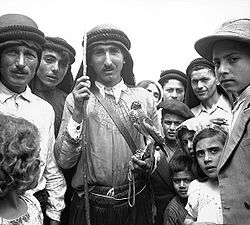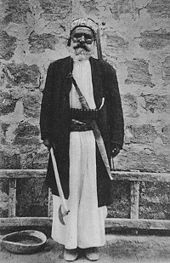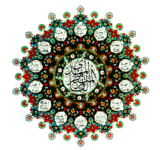‘Alawi
From Wikipedia, the free encyclopedia
- For the Alaouite dynasty of Morocco see Alaouite Dynasty, for the former state now in Yemen see Alawi (sheikhdom)
 Alawi falconer in Banyas, Syria, during World War II. |
|
| Total population | |
|---|---|
| More than 3 million[1] | |
| Founder | |
| Ibn Nuṣayr | |
| Regions with significant populations | |
| About 1.35 million[1] | |
| An estimated 100.000[2] | |
| About 1 million, stretching from Mersin, Tarsus, Adana to Antakya[3] | |
| Golan Heights | About 2000 live in Ghajar, a village in the Golan Heights[4] |
| There is a large Alawi community in Australia, but its population is unknown. | |
| Religions | |
| Shia Islam | |
| Scriptures | |
| Qur'an, Kitab al Majmu[5] | |
| Languages | |
| Arabic, Turkish | |
The Alawis or Alawites (‘Alawīyyah Arabic: علوية, also known as Nuṣayrī Arabic: نصيريون, an-Naṣīriyyah, and al-Anṣāriyyah) are a prominent minority religious group in Syria who describe themselves as a sect of Shī‘ah Islam. [6] [7] Alawis are distinct from the Turkish-based Alevi religious sect, although the terms share similar etymologies, and the sects may share a common origin.
The Alawis take their name from ‘Alī ibn Abī Ṭālib, cousin and son-in-law of Muḥammad,[8] who was the first Shi'a Imam and the 4th and last "Rightly Guided Caliph" of Sunni Islam. There are four Alawi confederations — Kalbiyah, Khaiyatin, Haddadin, and Matawirah — each divided into tribes.[1] Alawis are concentrated in the Latakia region of Syria, extending north to Antioch (Antakya), Turkey, and in and around Hims and Hama.[9]
Contents |
[edit] History
The origin of the Alawis is disputed. Some believe them to be descended from people who lived in this region at the time of Alexander the Great.[citation needed] The Alawis themselves trace their origins to the followers of the eleventh Imām, Hassan al-‘Askarī (d. 873), and his pupil ibn Nuṣayr (d. 868). [10]
The sect seems to have been organised by a follower of Muḥammad ibn Nuṣayr known as al-Khasibi, who died in Aleppo about 969. In 1032, Al-Khaṣībī’s grandson and pupil al-Tabarani moved to Latakia, which was then controlled by the Byzantine Empire. Al-Tabarani became the perfector of the ‘Alawi faith through his numerous writings. He and his pupils converted the rural population of the Syrian coastal mountain range and the plain of Cilicia to the ‘Alawi faith.[11] Under the Ottoman Empire they were ill treated,[1] and they resisted an attempt to convert them to Sunni Islam.[12] After the fall of the Ottoman Empire, Syria and Lebanon came under a French mandate. The French, when they occupied Syria in 1920, recognized the term "Alawi", gave autonomy to them and other minority groups, and accepted them into their colonial troops.[13] Under the mandate, many Alawi chieftains supported the notion of a separate Alawi nation and tried to convert their autonomy into independence. A territory of "Alaouites" was created in 1925. In May 1930, the Government of Latakia was created; it lasted until February 28, 1937, when it was incorporated into Syria.

In 1939, a portion of northwest Syria, the Sanjak of Alexandretta, now Hatay, that contained a large number of Alawis, was given to Turkey by the French, greatly angering the Alawi community and Syrians in general. Zaki al-Arsuzi, the young Alawi leader from Iskandarun province in the Sanjak of Alexandretta, who led the resistance to the annexation of his province to the Turks, later became a founder of the Ba'ath Party along with the Eastern Orthodox Christian schoolteacher Michel Aflaq. After World War II, Salman Al Murshid played a major role in uniting the Alawi province with Syria. He was executed by the newly independent Syrian government in Damascus on December 12, 1946 only three days after a hasty political trial.
Syria became independent on April 16, 1946. Following the 1948 Arab-Israeli War, Syria endured a succession of military coups in 1949, the rise of the Ba'ath Party, and unification of the country with Egypt in the United Arab Republic in 1958. The UAR lasted for three years and broke apart in 1961, when a group of army officers seized power and declared Syria independent again. A further succession of coups ensued until a secretive military committee, which included a number of disgruntled Alawi officers, including Hafez al-Assad and Salah Jadid, helped the Ba'ath Party take power in 1963. In 1966, Alawi-oriented military officers successfully rebelled and expelled the old Ba'ath that had looked to the Christian Michel Aflaq and the Sunni Muslim Salah al-Din al-Bitar for leadership. They promoted Zaki al-Arsuzi as the "Socrates" of their reconstituted Ba'ath Party.
In 1970, then-Air Force Colonel Hafez al-Assad took power and instigated a "Correctionist Movement" in the Ba'ath Party.[14] His coming to power has been compared to "an untouchable becoming maharajah in India or a Jew becoming tsar in Russia — an unprecedented development shocking to the majority population which had monopolized power for so many centuries."[13]
In 1971, al-Assad became president of Syria, a function that the Constitution allows only a Muslim to hold. In 1973 a new constitution was published that omitted this requirement. Protests erupted and this was changed,[15] and to satisfy this requirement in 1974, Musa Sadr, a leader of the Twelvers of Lebanon and founder of the Amal Movement, issued a fatwa stating that Alawis were a community of Twelver Shia Muslims.[16][17] Under the dictatorial but secular Assad regime, religious minorities were tolerated, political dissent was not.
After the death of Hafez al-Assad in 2000, his son Bashar al-Assad maintained the outlines of his father's regime.[citation needed] Although the Alawis predominate among the top military and intelligence offices, the civilian government and national economy is largely led by Sunnis, who represent about 70% of Syria's population.[citation needed] The Assad regime is careful to allow all of the religious sects a share of power and influence in the government. Today the Alawis exist as a minority but politically powerful sect in Syria.
[edit] Beliefs of the Alawis

Alawis are self-described Shi'i Muslims, and have been called Shia by other sources[6][7] including the highly influential Lebanese Shia cleric Musa al-Sadr of Lebanon.[16] On the other hand, conservative Sunnis do not always recognize Alawi as Muslims.[1] At least one source has compared them to Baha'is, Babis, Bektashis, Ahmadis, and "similar groups that have arisen within the Muslim community," and declared that "it has always been the consensus of the Muslim Ulama, both Sunni and Shi'i, that the Nusairi Alawi are kuffar unbelievers and mushrikun polytheists."[18]
[edit] Heterodox
Many of the tenets of the faith are secret and known only to a select few Alawi.[1] In the 19th and 20th centuries, however, an Alawite named Sulaiman al-Adni converted to Christianity and compiled a book called Al-Bakurah as-Suliamaniya fi Kashf Asrar ad-Diyanah an-Nusairiyah (The First Fruits of Sulaiman in Revealing the Secrets of the Nusairi Religion) in 1863. Orientalists like Louis Massignon gained access to a number of Nusairi manuscripts.[18]
Until fairly recently Alawis were referred to as "Nusairis", named after Abu Shu'ayb Muhammad ibn Nusayr (d. ca 270 h, 863 AD) who is reported to have attended the circles of the last three Imams of the prophet Muhammad's line. According to a hostile source, the term "`Alawi" was first used by Western scholars in the nineteenth century. In September 1920, French occupational forces instituted the policy of referring to them by the term "`Alawi". Nusiris have allegedly "generally preferred" to be called `Alawis, because of its association with `Ali ibn Abi Talib, rather than Abu Shuaib Muhammad Ibn Nausir.[18]
According to some sources, Alawis (or Nusairis) have integrated doctrines from other religions, in particular from Ismaili Islam and Christianity.[1][17] According to scholar Cyril Glasse, it is thought that "as a small, historically beleaguered ethnic group", the Alawi "absorbed elements" from the different religions that influenced their area from Hellenistic times onward,[17] while maintaining their own beliefs, and "pretended to adhere to the dominant religion of the age."[17] Alawites are reported to celebrate certain Christian festivals, "in their own way",[17] including Christmas, Easter, and Palm Sunday, and their religious ceremonies make use of bread and wine.[13] Glasse writes that they also practice a religious feast called by the Persian name naw ruz.
Nusairis have much in common with the Ismailis in terms of overall beliefs, and they are sometimes regarded as "an offshoot of this group."[18] According to scholar Umar F. Abd-Allah, a Alawite named Sulaiman al-Adni converted to Christianity and in 1863 compiled a book called Al-Bakurah as-Suliamaniya fi Kashf Asrar ad-Diyanah an-Nusairiyah or The First Fruits of Sulaiman in Revealing the Secrets of the Nusairi Religion. From this and other sources Abd-Allah concludes that Alawis, like the Ismailis and related groups, believe that the Shariah has both an esoteric, allegorical (Batini) meaning and an exoteric, literal (zahiri) meaning and that only the hidden meaning is intended. Alawis believe the exoteric meaning is known only to the Imams and later to the Bab and was hidden even to the Islamic prophet Muhammad himself. Only the Bab has access to this esoteric meaning in the absence of the Imam. [18]
Alawites believe in a "trinity" [1] or "schema"[17] of `Ain-Mim-Sin, which stands for `Ali, Muhammad, and Salman al-Farsi, the Persian Companion of Muhammad. Muhammad is known as ism, or "name", Ali as bab, or "door", and Salman al-Farsi as ma'na, or "meaning", with both Muhammad and Ali considered to be emanations of Salman al-Farsi.[17] According to Abd-Allah, each of these three is said to have been an incarnation of God. Ali, however, constitutes the most important part of this trinity. The Alawi testimony of faith is: `I have borne witness that there is no God but He, the most High, the object of worship [al-'Ali al-Ma'bud] and that there is no concealing veil (hijab) except the lord Muhammad, the object of praise, (as-Sayyid Muhmmad al-Mahmud), and there is not Bab except the lord Salman al-Farisi` The Nusairis believe in the subsequent incarnation of God in other persons after the passing of `Ali, Muhammad, and Salman al-Farisi...[18]
[edit] Orthodox
Some sources have suggested that the non-Muslim nature of many of the historical Alawi beliefs notwithstanding, Alawi beliefs may have changed in recent decades. In the early 1970s a booklet entitled al-`Alwaiyyun Shi'atu Ahl al-Bait (The Alawis are Followers of the Household of the Prophet), was issued in which doctrines of the Imami Shi'ah were described as 'Alawi, and which was "signed by of numerous `Alawi` men of religion".[18] This book and Musa Sadr's proclamation have led one scholar to wonder whether "a mass conversion from Nusairism to Shi'ah Islam" has taken place.[18] Another scholar suggests that factors such as the high profile of Alawi in Syria, the strong aversion of the Muslim majority to apostasy, and the relative lack of importance of religious doctrine to Alawi identity may have induced Syrian leader Hafez al-Assad and his successor son to press their fellow Alawi "to behave like "`regular Muslims`, shedding or at least concealing their distinctive aspects." [19]
Alawis have their own scholars, referred to as shaikhs, although more recently there has been a movement to bring Alawism and the other branches of Twelver Islam together through educational exchange programs in Syria and Qumm.[citation needed]
[edit] Population

Traditionally Alawis live in the mountains along the Mediterranean coast of Syria. Latakia and Tartous are the region's principal cities. Alawis are also concentrated in the plains around Hama and Homs. They were divided into four confederations — Kalbiyah, Khaiyatin, Haddadin, and Matawirah — each divided into tribes.[1]
Today, Alawis also live in all major cities of Syria. They were never estimated as more than 20% of the Syrian population (which would be about 3 million people if true today).
Before 1953, they had reserved seats in the Syrian Parliament, like all other religious communities. After that, including for the 1960 census, there were only general Muslim and Christian categories, without mention of subgroups in order to reduce "communalism" (taïfiyya).
There are an estimated 100,000[20] Alawis in Lebanon, where they are recognized as one of the 18 official Lebanese sects. Due to the efforts of their leader Ali Eid, the Taif Agreement of 1989 gave them two reserved seats in the Parliament. Lebanese Alawis live mostly in Tripoli and small villages in Akkar, in villages including Massoudieh and al-Hisah.
There were 185 000 Alawis in Turkey in 1970[21] (this number suggest ca 400 000 in 2009). They live mostly in the Hatay, Adana and Mersin provinces of Southern Turkey.
There are also about 2000 Alawis living in the village of Ghajar, split between Lebanon and the Israeli occupied Golan Heights, alongside Druze.[22]
[edit] See also
[edit] References
- ^ a b c d e f g h i Alawi Islam globalsecurity.org
- ^ "Tharwa Project". http://www.tharwaproject.com/node/2127. "The Alawis have been present in modern-day Lebanon since the 16th century and are estimated to number 100,000 today, mostly in Akkar and Tripoli. The sect is managed through the Islamic Alawi Union, a council of 600 members that are elected every four years."
- ^ "Nusayriler hakkında ansiklopedik bilgi.". Bibilgi.com. http://www.bibilgi.com/Nusayriler. Retrieved 2010-01-17.
- ^ "CIA - The World Factbook - Syria". https://www.cia.gov/library/publications/the-world-factbook/geos/sy.html.
- ^ "Alawi Islam". GlobalSecurity.org. http://www.globalsecurity.org/military/intro/islam-alawi.htm. Retrieved 2008-05-31. "Their prayer book, the source of religious instruction, is the Kitāb al-Majmu‘, believed to be derived from Ismā‘īlī writings. Alawis study the Qur'ān and recognize the five pillars of Islam, which they interpret in a wholly allegorical sense to fit community tenets."
- ^ a b Kramer, Martin. "Syria’s '‘Alawis and Shi‘ism". http://www.geocities.com/martinkramerorg/’Alawīs.htm. "In their mountainous corner of Syria, the ‘Alawī claim to represent the furthest extension of Twelver Shi'ism."
- ^ a b Fisk, Robert. "This election will change the world. But not in the way the Americans imagined.". The Independent UK. http://www.robert-fisk.com/articles452.htm. Retrieved 2006-10-21. "But outside Iraq, Arab leaders are talking of a Shia "Crescent" that will run from Iran through Iraq to Lebanon via Syria, whose Alawi leadership forms a branch of Shia Islam."
- ^ Kaplan, Robert (1993-02). "Syria: Identity Crisis". TheAtlantic.com. http://www.theatlantic.com/doc/199302/kaplan. "The term "‘Alawī" means "follower of Ali," the martyred son-in-law of Mohammed who is venerated by millions of Shi'ites in Iran and elsewhere."
- ^ Encyclopædia Britannica. "Encyclopaedia Britannica". Britannica.com. http://www.britannica.com/EBchecked/topic/12399/Alawite. Retrieved 2010-01-17.
- ^ "Alawi Islam in the 11th Encyclopædia Britannica". 1911. http://www.1911encyclopedia.org/Nosairis. "Among the more plausible explanations is that the name is derived from that of Muhommed ibn Nusair, who was an Isma'ilite follower of the eleventh imam of the Shiites at the end of the 9th century. This view has been accepted by Nosairi writers, but they transfer Ibn Nusair to the 7th century and make him the son of the vizier of Moawiya I."
- ^ "Shi'ism, by Heinz Halm, pg.157". Books.google.com.au. http://books.google.com.au/books?id=u5jO3QzVtPUC&pg=PA28&dq=kaysanite&lr=&as_brr=3#v=onepage&q=kaysanite&f=false. Retrieved 2010-01-17.
- ^ Seale, Patrick. Asad Of Syria : The Struggle For The Middle East / Patrick Seale With The Assistance Of Maureen McConville. Seale, Patrick. Berkeley : University of California Press, 1989, c1988.
- ^ a b c Kaplan, Robert (1993-02). "Syria: Identity Crisis". TheAtlantic.com. http://www.theatlantic.com/doc/199302/kaplan.
- ^ Kaplan, Robert (1993-02). "Syria: Identity Crisis". TheAtlantic.com. http://www.theatlantic.com/doc/199302/kaplan. "But the coup of 1970, which brought an Alawi air force officer, Hafez al-Assad, to power, was what finally ended the instability that had reigned in Syria since the advent of independence."
- ^ Seale, Patrick, Asad, the Struggle for the Middle East, University of California Press, 1989, p.173
- ^ a b Kaplan, Robert (1993-02). "Syria: Identity Crisis". TheAtlantic.com. http://www.theatlantic.com/doc/199302/kaplan. "Today, those Muslims called Alawīs are brothers of those Shi'ites called Mutawallis by the malicious."
- ^ a b c d e f g The New Encyclopedia of Islam by Cyril Glasse, Altamira, 2001, p.36-7
- ^ a b c d e f g h Abd-Allah, Umar F., Islamic Struggle in Syria, Berkeley : Mizan Press, c1983, p.43-48
- ^ Rubin, Barry, The Truth about Syria, by Barry Rubin, Palgrave Macmillan, 2007, p.49
- ^ TDS (dead link)
- ^ State and rural society in medieval Islam: sultans, muqtaʻs, and fallahun. Leiden: E.J. Brill. 1997. p. 162. ISBN 90-04-10649-9.
- ^ "Getting rid of Ghajar - Haaretz - Israel News". Haaretz. http://www.haaretz.com/hasen/spages/1084425.html. Retrieved 2010-01-17.
[edit] External links
- Islamic Education in Syria by Joshua Landis
- Nosairi
- Seven Pillars of Wisdom T. E. Lawrence on Syrians, including Nosaris/’Alawīs
- Ibn Taymiyya's Fatwa against the Nosairi A .pdf file
- Nusayri



